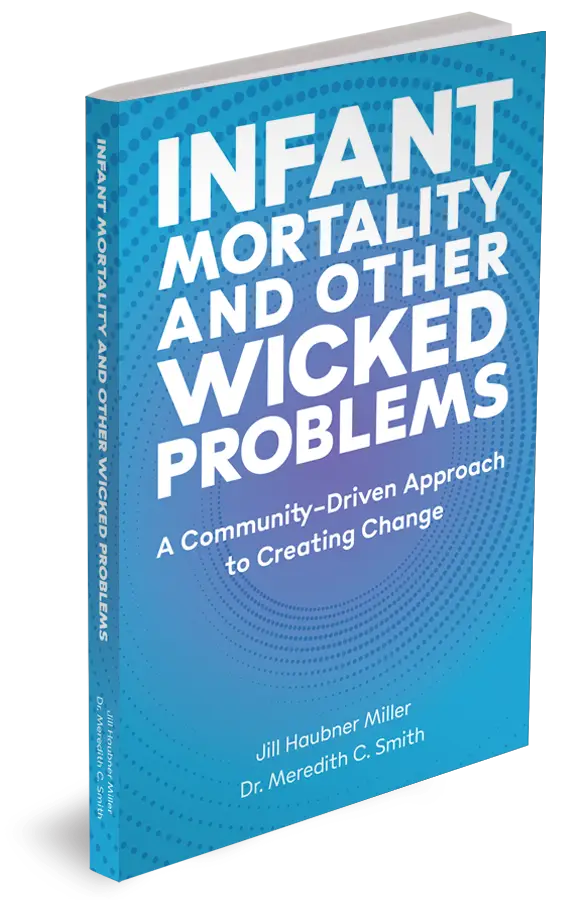

FOR IMMEDIATE RELEASE
Keeping Babies Alive: New book chronicles Cincinnati’s successful efforts to reduce infant mortality
Offers roadmap for other communities to address complex challenges
CINCINNATI, OH — A powerful new book, Infant Mortality and Other Wicked Problems, sheds light on how Greater Cincinnati took collective action to address one of its most pressing public health challenges—infant mortality. Co-authored by bi3 Fund President & CEO Jill Miller and Cradle Cincinnati Executive Director Dr. Meredith Smith, the book explores how local healthcare systems, nonprofit organizations, community leaders, and residents united to drive change and save lives.
“Cincinnati’s journey to reducing infant mortality is a story of innovation, collaboration, and persistence. More than 220 babies—picture eight classrooms of kids—are alive today because of the efforts in our community,” Miller said. “By sharing our lessons learned, we hope to inspire other communities to tackle their own complex challenges.”
Over the past decade, the collaborative efforts outlined in the book have led to Hamilton County achieving its lowest infant mortality rate on record. The book builds on these successes, laying out a blueprint for addressing complex health and social issues, with actionable insights for community leaders, policymakers, and health professionals nationwide.
“Our goal is to show that change is possible when communities come together and actively listen to and engage with those at the center of the problems we are trying to solve,” Smith said. “This book serves as both a reflection of Cincinnati’s progress and a call to action for others.”
A practical framework for systems change that every community can use:
Let data be a guiding force. When tackling a wicked problem, gather as much research, facts, and statistics as possible. Committing to collecting accurate data and making decisions grounded in research, better positions any initiative for success.
Challenge assumptions. Everyone has beliefs and biases that influence the interpretation of data and situations and can make it easy to miss underlying persuasive problems. Leaving preconceived theories behind can better lead to identifying root causes and solutions for a community’s wicked problem.
Create a strong narrative. Stories can help people both identify with and understand a wicked problem. Developing a strong and consistent narrative is a critical step in securing funding, community support and the start of building a movement for change.
Learn as much as you can from others. Seek out experts, research, and study best practices in other communities. Even if the road map for changes does not precisely match another community, there is a lot to learn from others that can help rule out dead ends and identify potential solutions.
Try something new and scale what works. Innovation is critical to tackling wicked problems, examining problems from different angles, and thinking creatively about new solutions. Scaling can often take time and require customization and tailoring in other communities with different assets and cultures.
Build a movement. People are the building blocks of any movement. While organic growth is essential, it’s also important to be intentional about the types of people brought to the table. As more people become involved, it’s important to lean into the consistent narrative while empowering the people most affected by the wicked problem.
Listen to those most affected. When trying to solve a complex problem, engaging people at the center of the issue is imperative. They are experts in the barriers they are facing and what support is most likely to work. This can’t be a single conversation; continuing to engage people with lived experience will continue to inform successful solutions.
Co-design sustainable solutions. Solutions should be designed alongside those affected by the problem, creating a program formalizing best practices, processes, and tactics.
Engage in advocacy. Advocacy is an essential part of creating lasting change. This can mean engaging leaders at the local, state, and federal levels to address barriers to solving your wicked problems. Build partnerships with other organizations and look for partners in the professional sectors.
Secure funding. Funding can be one of the most important parts of designing and implementing any initiative. Securing funding can depend on several factors including geography, focus, or existing partnerships. Think about sustainability from day one and build relationships with identified funding sources.
Infant Mortality and Other Wicked Problems is available now on Amazon.


To engage Jill Haubner Miller and Dr. Meredith C. Smith for speaking and break-out sessions, please contact them.